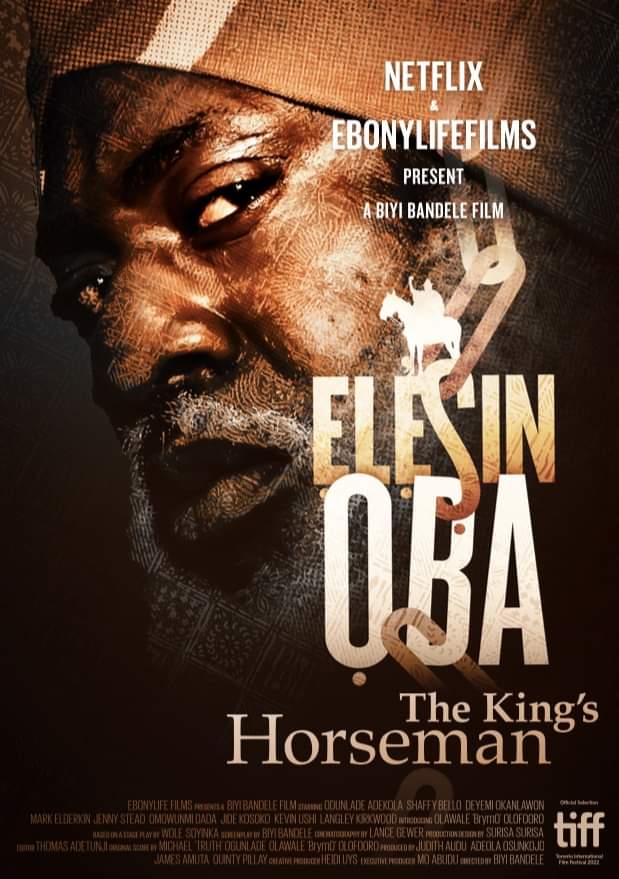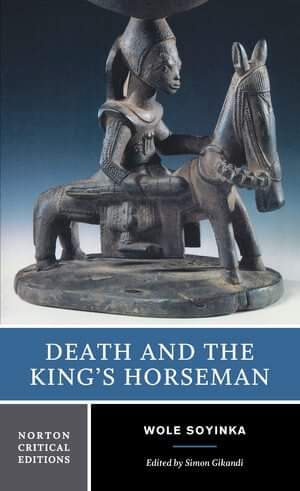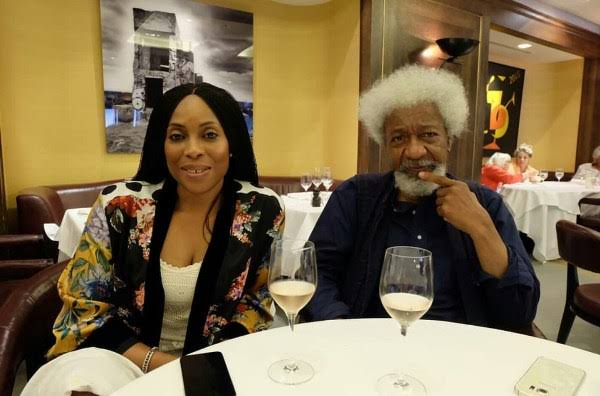 𝐄𝐥𝐞𝐬𝐡𝐢𝐧 𝐎𝐛𝐚 𝐓𝐫𝐚𝐯𝐞𝐥𝐬 𝐋𝐢𝐠𝐡𝐭 𝐟𝐫𝐨𝐦 𝐏𝐚𝐠𝐞 𝐭𝐨 𝐒𝐭𝐚𝐠𝐞 𝐭𝐨 𝐒𝐜𝐫𝐞𝐞𝐧: 𝐍𝐨𝐥𝐥𝐲𝐰𝐨𝐨𝐝 𝐚𝐧𝐝 𝐅𝐢𝐥𝐦 𝐀𝐝𝐚𝐩𝐭𝐚𝐭𝐢𝐨𝐧
𝐄𝐥𝐞𝐬𝐡𝐢𝐧 𝐎𝐛𝐚 𝐓𝐫𝐚𝐯𝐞𝐥𝐬 𝐋𝐢𝐠𝐡𝐭 𝐟𝐫𝐨𝐦 𝐏𝐚𝐠𝐞 𝐭𝐨 𝐒𝐭𝐚𝐠𝐞 𝐭𝐨 𝐒𝐜𝐫𝐞𝐞𝐧: 𝐍𝐨𝐥𝐥𝐲𝐰𝐨𝐨𝐝 𝐚𝐧𝐝 𝐅𝐢𝐥𝐦 𝐀𝐝𝐚𝐩𝐭𝐚𝐭𝐢𝐨𝐧
𝑆𝑖𝑟, ℎ𝑎𝑣𝑒 𝑦𝑜𝑢 𝑤𝑎𝑡𝑐ℎ𝑒𝑑 𝑡ℎ𝑒 𝑓𝑖𝑙𝑚?
𝑊ℎ𝑎𝑡 𝑓𝑖𝑙𝑚?
𝐸𝑙𝑒𝑠ℎ𝑖𝑛 𝑂𝑏𝑎.
𝑌𝑒𝑠.
𝑇ℎ𝑒 𝑓𝑖𝑙𝑚 𝑖𝑠 𝑠𝑜𝑚𝑒ℎ𝑜𝑤.
𝐻𝑜𝑤 𝑠𝑜𝑚𝑒ℎ𝑜𝑤?
𝐸𝑚…𝑒𝑚…𝑆𝑜𝑚𝑒ℎ𝑜𝑤 𝑠ℎ𝑎!
Wole Soyinka’s 𝐷𝑒𝑎𝑡ℎ 𝑎𝑛𝑑 𝑡ℎ𝑒 𝐾𝑖𝑛𝑔’𝑠 𝐻𝑜𝑟𝑠𝑒𝑚𝑎𝑛 (1975) is not an ordinary play, and it is not written for ordinary folks. It may have ordinary folks but not ordinary issues. The issues are beyond the ordinary and they require a higher intellect to be fully appreciated. They are beyond the “clash of cultures” and above the “clash of civilizations”. They are esoteric philosophical discourses demanding the brains that are ready and willing to dare the transition. They require brave hearts that are prepared to fill the lacuna between the transitions from the world of the living to the dead and to the unborn. They are not for lilliputians with no chthonic power to bridge the planes across the gulf and into the abyss. They are for pathfinders with the Ogunian spirit to dare the crucibles of the Fourth stage. They are….
𝐻𝑎𝑎𝑎! 𝐸 𝑔𝑏𝑎 𝑚𝑖! 𝐾𝑖𝑙𝑜𝑑𝑒! 𝐴ℎ𝑎, 𝑘𝑖 𝑙𝑎 𝑔𝑏𝑒, 𝑘𝑖 𝑙𝑒 𝑗𝑢? 𝑆𝑖𝑟, 𝑎𝑏𝑒𝑔, 𝑡𝑎𝑘𝑒 𝑖𝑡 𝑒𝑎𝑠𝑦…𝑐𝑜𝑚𝑒 𝑡𝑜 𝑚𝑦 𝑙𝑒𝑣𝑒𝑙.
𝑆𝑜𝑟𝑟𝑦, 𝑝𝑙𝑒𝑎𝑠𝑒. 𝐼𝑡’𝑠 𝑛𝑜𝑡 𝑚𝑦 𝑓𝑎𝑢𝑙𝑡. 𝐼𝑡 𝑖𝑠 𝑡ℎ𝑒 𝑝𝑙𝑎𝑦…
𝑆𝑖𝑟, 𝑖𝑡 𝑠𝑒𝑒𝑚𝑠 𝑤𝑒 𝑎𝑟𝑒 𝑛𝑜𝑡 𝑡𝑎𝑙𝑘𝑖𝑛𝑔 𝑎𝑏𝑜𝑢𝑡 𝑡ℎ𝑒 𝑠𝑎𝑚𝑒 𝑡ℎ𝑖𝑛𝑔.
𝑊ℎ𝑎𝑡 𝑎𝑟𝑒 𝑦𝑜𝑢 𝑡𝑎𝑙𝑘𝑖𝑛𝑔 𝑎𝑏𝑜𝑢𝑡?
𝐸𝑙𝑒𝑠ℎ𝑖𝑛 𝑂𝑏𝑎: 𝑇ℎ𝑒 𝐾𝑖𝑛𝑔’𝑠 𝐻𝑜𝑟𝑠𝑒𝑚𝑎𝑛, 𝑡ℎ𝑒 𝑚𝑜𝑣𝑖𝑒 𝑜𝑛 𝑁𝑒𝑡𝑓𝑙𝑖𝑥 𝑑𝑖𝑟𝑒𝑐𝑡𝑒𝑑 𝑏𝑦 𝐵𝑖𝑦𝑖 𝐵𝑎𝑛𝑑𝑒𝑙𝑒
𝐷𝑒𝑎𝑡ℎ 𝑎𝑛𝑑 𝑡ℎ𝑒 𝐾𝑖𝑛𝑔’𝑠 𝐻𝑜𝑟𝑠𝑒𝑚𝑎𝑛 𝑤𝑟𝑖𝑡𝑡𝑒𝑛 𝑏𝑦 𝑊𝑜𝑙𝑒 𝑆𝑜𝑦𝑖𝑛𝑘𝑎
𝑆𝑖𝑟, 𝑡ℎ𝑖𝑠 𝑜𝑛𝑒 𝑜𝑛 𝑁𝑒𝑡𝑓𝑙𝑖𝑥 𝑖𝑠 𝑛𝑜𝑡 𝑤𝑟𝑖𝑡𝑡𝑒𝑛 𝑏𝑦 𝑆𝑜𝑦𝑖𝑛𝑘𝑎 𝑜
𝐸𝑙𝑒𝑠ℎ𝑖𝑛 𝑂𝑏𝑎 𝑎𝑛𝑑 𝐷𝑒𝑎𝑡ℎ 𝑎𝑛𝑑 𝑡ℎ𝑒 𝐾𝑖𝑛𝑔’𝑠 𝐻𝑜𝑟𝑠𝑒𝑚𝑎𝑛 𝑎𝑟𝑒 𝑡ℎ𝑒 𝑠𝑎𝑚𝑒.
𝐴𝑟𝑒 𝑡ℎ𝑒𝑦?
𝑊𝑒𝑙𝑙, 𝑦𝑒𝑠 𝑎𝑛𝑑 𝑛𝑜. 𝐿𝑒𝑡 𝑚𝑒 𝑒𝑥𝑝𝑙𝑎𝑖𝑛.
𝐸𝑙𝑒𝑠ℎ𝑖𝑛 𝑂𝑏𝑎: 𝑇ℎ𝑒 𝐾𝑖𝑛𝑔’𝑠 𝐻𝑜𝑟𝑠𝑒𝑚𝑎𝑛 (2022) is a film adaptation of Soyinka’s 𝐷𝑒𝑎𝑡ℎ 𝑎𝑛𝑑 𝑡ℎ𝑒 𝐾𝑖𝑛𝑔’𝑠 𝐻𝑜𝑟𝑠𝑒𝑚𝑎𝑛. Film Adaptation has been in existence for several centuries. From around 200BC to 300AD, many classical Roman playwrights such as Livius Andronicus, Gnaeus Naevius, and Plautus adapted classical Greek plays just as the Renaissance playwrights like Williams Shakespeare and Christopher Marlowe adapted both the classical Greek and Roman plays. In fact, William Shakespeare’s plays have been adapted in all the eras after the Renaissance and they have been translated into several languages. His plays have been adapted for cinemas, home movies, radio dramas, cartoons, and films. In fact, most great playwrights and movie directors are involved in one form of play adaptation or film adaptation. From Hollywood to Ghallywood, and Bollywood to Borehamwood, all nations of the world take pride in their histories of film adaptations. Film adaptations … from 𝑇𝑖𝑡𝑎𝑛𝑖𝑐 to 𝑇ℎ𝑒 𝐷𝑎 𝑉𝑖𝑛𝑐𝑖 𝐶𝑜𝑑𝑒, from 𝑂𝑚𝑘𝑎𝑟𝑎 to 𝑆𝑙𝑢𝑚𝑑𝑜𝑔 𝑀𝑖𝑙𝑙𝑖𝑜𝑛𝑎𝑖𝑟𝑒 and from Achebe’s 𝑇ℎ𝑖𝑛𝑔𝑠 𝐹𝑎𝑙𝑙 𝐴𝑝𝑎𝑟𝑡 to Saro-Wiwa’s 𝐵𝑎𝑠𝑖 𝑎𝑛𝑑 𝐶𝑜𝑚𝑝𝑎𝑛𝑦 and Wale Ogunyemi’s 𝐸𝑛𝑖𝑦𝑎𝑛. Film Adaptation … film adaptation is….
 𝑆𝑖𝑟, 𝑤ℎ𝑎𝑡 𝑖𝑠 𝑡ℎ𝑖𝑠 𝑓𝑖𝑙𝑚 𝑎𝑑𝑎𝑝𝑡𝑎𝑡𝑖𝑜𝑛 𝑔𝑎𝑛𝑔𝑎𝑛?
𝑆𝑖𝑟, 𝑤ℎ𝑎𝑡 𝑖𝑠 𝑡ℎ𝑖𝑠 𝑓𝑖𝑙𝑚 𝑎𝑑𝑎𝑝𝑡𝑎𝑡𝑖𝑜𝑛 𝑔𝑎𝑛𝑔𝑎𝑛?
𝐼𝑡 𝑖𝑠 𝑙𝑖𝑘𝑒 𝑒𝑎𝑡𝑖𝑛𝑔 𝑡𝑢𝑤𝑜𝑛 𝑠ℎ𝑖𝑛𝑘𝑎𝑓𝑎 𝑜𝑟 𝑎𝑚𝑎𝑙𝑎 𝑤𝑖𝑡ℎ 𝑓𝑜𝑟𝑘 𝑠𝑝𝑜𝑜𝑛 𝑜𝑟 𝑐ℎ𝑜𝑝𝑠𝑡𝑖𝑐𝑘 𝑡𝑜 𝑚𝑎𝑘𝑒 𝐴𝑚𝑒𝑟𝑖𝑐𝑎𝑛𝑠 𝑎𝑛𝑑 𝐶ℎ𝑖𝑛𝑒𝑠𝑒 𝑠𝑎𝑙𝑖𝑣𝑎𝑡𝑒.
𝑌𝑜𝑢 𝑑𝑜𝑛’𝑡 𝑚𝑒𝑎𝑛 𝑖𝑡, 𝑆𝑖𝑟?
𝐼𝑡 𝑖𝑠 𝑙𝑖𝑘𝑒 𝑠𝑤𝑎𝑝𝑝𝑖𝑛𝑔 𝐵𝑟𝑢𝑐𝑒 𝐿𝑒𝑒 𝑎𝑛𝑑 𝐽𝑎𝑐𝑘𝑦 𝐶ℎ𝑎𝑛 𝑓𝑜𝑟 𝐴𝑘𝑖 𝑎𝑛𝑑 𝑃𝑎𝑤𝑝𝑎𝑤 𝑡𝑜 𝑚𝑎𝑘𝑒 𝑡ℎ𝑒𝑚 𝑎𝑝𝑝𝑒𝑎𝑙𝑖𝑛𝑔 𝑎𝑛𝑑 𝑢𝑛𝑑𝑒𝑟𝑠𝑡𝑜𝑜𝑑 𝑡𝑜 𝑡ℎ𝑒 𝑁𝑖𝑔𝑒𝑟𝑖𝑎𝑛 𝑎𝑢𝑑𝑖𝑒𝑛𝑐𝑒𝑠.
𝑆𝑖𝑟, 𝑝𝑙𝑒𝑎𝑠𝑒 𝑏𝑒 𝑠𝑒𝑟𝑖𝑜𝑢𝑠.
𝐼𝑡 𝑖𝑠 𝑡ℎ𝑒 𝑎𝑐𝑡 𝑜𝑓 𝑡𝑢𝑟𝑛𝑖𝑛𝑔 𝑝𝑟𝑒-𝑒𝑥𝑖𝑠𝑡𝑖𝑛𝑔 𝑠𝑡𝑜𝑟𝑖𝑒𝑠 𝑜𝑟 𝑖𝑑𝑒𝑎𝑠 𝑓𝑟𝑜𝑚 𝑤𝑟𝑖𝑡𝑡𝑒𝑛 𝑤𝑜𝑟𝑘𝑠 𝑙𝑖𝑘𝑒 𝑛𝑜𝑣𝑒𝑙, 𝑝𝑜𝑒𝑚, 𝑎𝑛𝑑 𝑑𝑟𝑎𝑚𝑎 𝑖𝑛𝑡𝑜 𝑎 𝑓𝑖𝑙𝑚, 𝑡𝑒𝑙𝑒𝑣𝑖𝑠𝑖𝑜𝑛 𝑑𝑟𝑎𝑚𝑎 𝑎𝑛𝑑 𝑓𝑜𝑟 𝑐𝑖𝑛𝑒𝑚𝑎
𝑆𝑖𝑟, 𝐼 𝑡ℎ𝑖𝑛𝑘 𝑡ℎ𝑎𝑡 𝑖𝑠 𝑠𝑡𝑒𝑎𝑙𝑖𝑛𝑔 𝑜𝑓 𝑠𝑜𝑚𝑒𝑜𝑛𝑒 𝑒𝑙𝑠𝑒’𝑠 𝑖𝑑𝑒𝑎.
𝑁𝑜. 𝐼𝑡’𝑠 𝑛𝑜𝑡.
𝐼𝑓 𝐼 𝑎𝑚 𝑆𝑜𝑦𝑖𝑛𝑘𝑎, 𝐼 𝑤𝑖𝑙𝑙 𝑠𝑢𝑒 𝑡ℎ𝑒𝑚.
I saw the picture taken in 2018 when Mo Abudu and Professor Soyinka agreed to turn his literary work into a film. So, it must have been done with his consent. And Soyinka is not the first person whose play would be adapted for film in Nigeria. Film adaptation in Nigeria predated Nollywood. Folktales, stories, novels, poems, and songs have been adapted as far back as the time of Hubert Ogunde, Moses Olaiya (Baba Sala), and Adeyemi Afolayan (Ade Love) (1940-1996). Chinua Achebe’s 𝑇ℎ𝑖𝑛𝑔𝑠 𝐹𝑎𝑙𝑙 𝐴𝑝𝑎𝑟𝑡 (1958) was adapted for radio drama in 1961 and released for movies in 1972. Adebayo Faleti’s novel 𝐼𝑗𝑎 𝑂𝑚𝑖𝑛𝑖𝑟𝑎 was adapted for Yoruba film by Ola Balogun in 1979. Fast forward to the 1990s and the emergence of the Nigerian film industry, Nollywood, film adaptation became regular features of the repertoire of Nigerian movies. In 1995, Tunde Kelani adapted for film, 𝑆𝑎𝑤𝑜𝑟𝑜𝑖𝑑𝑒 a novel by Akinwunmi Ishola. In 1998, a novel, 𝑇ℎ𝑒 𝑉𝑖𝑟𝑔𝑖𝑛 by Bayo Adebowale was adapted for film, 𝑇ℎ𝑒 𝑊ℎ𝑖𝑡𝑒 𝐻𝑎𝑛𝑑𝑘𝑒𝑟𝑐ℎ𝑖𝑒𝑓 by Tunde Kelani. Kola Akinlade’s novel, 𝑂𝑤𝑜 𝐸𝑗𝑒 was adapted for film in 2005 by Yemi Aodu and Remi Ibitila. Other writers whose literary works have been adapted for film include Femi Osofisan’s 𝑀𝑎𝑎𝑚𝑖 released in 2011; Chimamanda Aditche’s 𝐻𝑎𝑙𝑓 𝑜𝑓 𝑎 𝑌𝑒𝑙𝑙𝑜𝑤 𝑆𝑢𝑛 adapted for film in 2013; Sefi Atta’s 𝑆𝑤𝑎𝑙𝑙𝑜𝑤 (2008) adapted for film by Kunle Afolayan in 2021; Ebi Akpeti’s 𝑇ℎ𝑒 𝑃𝑒𝑟𝑓𝑒𝑐𝑡 𝐶ℎ𝑢𝑟𝑐ℎ (2010) adapted for film by Wale Adenuga Productions in 2011; Olayinka Egbokhare’s 𝑇ℎ𝑒 𝐷𝑎𝑧𝑧𝑙𝑖𝑛𝑔 𝑀𝑖𝑟𝑎𝑔𝑒 (2007) adapted for film by Tunde Kelani in 2015. Lest I forget, 𝑎𝑦𝑖 𝑏𝑎 𝑤𝑜𝑛 𝑠𝑖 𝑛𝑖𝑏𝑒 𝑛𝑖 𝑎𝑦𝑖 𝑏𝑎𝑤𝑜𝑛 𝑑𝑎 𝑠𝑖, I have also contributed two literary works to the story of Nollywood film adaptation. My play, 𝑊ℎ𝑒𝑛 𝑡ℎ𝑒 𝐷𝑟𝑒𝑎𝑚 𝐷𝑖𝑒𝑠 (2005) was adapted for Yoruba film and titled, 𝑇𝑖 𝐴𝑙𝑎 𝐵𝑎𝑎𝑘𝑢 by Saheed Salami and Kehinde Salami in 2008; In 2013, 𝑇ℎ𝑒 𝐺𝑜𝑑𝑠 𝑎𝑟𝑒 𝑆𝑡𝑖𝑙𝑙 𝑛𝑜𝑡 𝑡𝑜 𝐵𝑙𝑎𝑚𝑒 (2012) was adapted for film by Funke Fayoyin. Go and verify!
𝐵𝑢𝑡 𝑆𝑖𝑟, 𝑖𝑓 𝑖𝑡 𝑖𝑠 𝑛𝑜𝑡 𝑃𝑎𝑛𝑎𝑑𝑜𝑙, 𝑖𝑡 𝑐𝑎𝑛𝑛𝑜𝑡 𝑏𝑒 𝑙𝑖𝑘𝑒 𝑃𝑎𝑛𝑎𝑑𝑜𝑙.
𝑊𝑒𝑙𝑙, 𝑦𝑜𝑢 𝑎𝑟𝑒 𝑟𝑖𝑔ℎ𝑡 𝑎𝑛𝑑 𝑤𝑟𝑜𝑛𝑔.
𝑆𝑖𝑟, 𝑎𝑡 𝑏𝑒𝑠𝑡, 𝑖𝑡 𝑐𝑎𝑛 𝑜𝑛𝑙𝑦 𝑏𝑒 𝑙𝑖𝑘𝑒 𝑃ℎ𝑒𝑛𝑠𝑖𝑐 𝑜𝑟 𝐼𝑏𝑟𝑢𝑝𝑜𝑓𝑒𝑛
𝐴𝑡 𝑙𝑒𝑎𝑠𝑡, 𝑡ℎ𝑒𝑦 𝑤𝑖𝑙𝑙 𝑠𝑒𝑟𝑣𝑒 𝑡ℎ𝑒 𝑠𝑎𝑚𝑒 𝑝𝑢𝑟𝑝𝑜𝑠𝑒 𝑎𝑛𝑑 𝑚𝑜𝑟𝑒…
𝑆𝑖𝑟, 𝑖𝑡 𝑖𝑠 𝑛𝑜𝑡 𝑝𝑜𝑠𝑠𝑖𝑏𝑙𝑒. 𝑆𝑖𝑑𝑒 𝑐ℎ𝑖𝑐𝑘 𝑎𝑛𝑑 𝑤𝑖𝑓𝑒 𝑐𝑎𝑛𝑛𝑜𝑡 𝑠𝑒𝑟𝑣𝑒 𝑡ℎ𝑒 𝑠𝑎𝑚𝑒 𝑝𝑢𝑟𝑝𝑜𝑠𝑒…
𝑊𝑒𝑙𝑙, 𝑛𝑜 𝑡𝑤𝑜 ℎ𝑢𝑚𝑎𝑛 𝑏𝑒𝑖𝑛𝑔𝑠 𝑎𝑟𝑒 𝑡ℎ𝑒 𝑠𝑎𝑚𝑒, 𝑒𝑣𝑒𝑛 𝑖𝑓 𝑡ℎ𝑒𝑦 𝑎𝑟𝑒 𝑆𝑖𝑎𝑚𝑒𝑠𝑒 𝑡𝑤𝑖𝑛𝑠
The original work and its adaptation may serve the same purpose. They may be like Siamese twins but occupying different spaces, places, and mediums just like 𝐸𝑙𝑒𝑠ℎ𝑖𝑛 𝑂𝑏𝑎: 𝑇ℎ𝑒 𝐾𝑖𝑛𝑔’𝑠 𝐻𝑜𝑟𝑠𝑒𝑚𝑎𝑛 and 𝐷𝑒𝑎𝑡ℎ 𝑎𝑛𝑑 𝑡ℎ𝑒 𝐾𝑖𝑛𝑔’𝑠 𝐻𝑜𝑟𝑠𝑒𝑚𝑎𝑛. They may be faithful to each other, they may be separated but not divorced and they may be divorced, separated, and not on talking terms. The ‘dialogic processes’ between them may reveal their filial relationships, hatred of each other, and betrayal, violation, and desecration of each other. They may be done to clarify the similarities and differences or agreements and disagreements that they have with each other. 𝐸𝑙𝑒𝑠ℎ𝑖𝑛 𝑂𝑏𝑎: 𝑇ℎ𝑒 𝐾𝑖𝑛𝑔’𝑠 𝐻𝑜𝑟𝑠𝑒𝑚𝑎𝑛 is obviously in love with 𝐷𝑒𝑎𝑡ℎ 𝑎𝑛𝑑 𝑡ℎ𝑒 𝐾𝑖𝑛𝑔’𝑠 𝐻𝑜𝑟𝑠𝑒𝑚𝑎𝑛, and it is very proud to flaunt their filial relationship. Its desire is to be faithful, truthful, honest, and resemble 𝐷𝑒𝑎𝑡ℎ 𝑎𝑛𝑑 𝑡ℎ𝑒 𝐾𝑖𝑛𝑔’𝑠 𝐻𝑜𝑟𝑠𝑒𝑚𝑎𝑛 in every way possible regardless of whose ox is gored, and regardless of whether those watching their relationship are close friends, acquaintances, or total strangers. 𝐸𝑙𝑒𝑠ℎ𝑖𝑛 𝑂𝑏𝑎: 𝑇ℎ𝑒 𝐾𝑖𝑛𝑔’𝑠 𝐻𝑜𝑟𝑠𝑒𝑚𝑎𝑛 is more concerned about transposition and less worried about commentary and analogy. It should however be stated that a relationship will be boring if one of the parties brings nothing to the relationship table. Therefore, both parties must bring something new to sustain interest in the relationship. As Morris Beja in 𝐹𝑖𝑙𝑚 𝑎𝑛𝑑 𝐿𝑖𝑡𝑒𝑟𝑎𝑡𝑢𝑟𝑒: 𝐴𝑛 𝐼𝑛𝑡𝑟𝑜𝑑𝑢𝑐𝑡𝑖𝑜𝑛 (1979) rightly observed, “’Of course what a film takes from a book matters; but so does what it brings to a book.” (88) The major thing which 𝐸𝑙𝑒𝑠ℎ𝑖𝑛 𝑂𝑏𝑎: 𝑇ℎ𝑒 𝐾𝑖𝑛𝑔’𝑠 𝐻𝑜𝑟𝑠𝑒𝑚𝑎𝑛 brings to the table and not shy to present to 𝐷𝑒𝑎𝑡ℎ 𝑎𝑛𝑑 𝑡ℎ𝑒 𝐾𝑖𝑛𝑔’𝑠 𝐻𝑜𝑟𝑠𝑒𝑚𝑎𝑛 is its voice, sound, and music. Much as it tries to please and emulate 𝐷𝑒𝑎𝑡ℎ 𝑎𝑛𝑑 𝑡ℎ𝑒 𝐾𝑖𝑛𝑔’𝑠 𝐻𝑜𝑟𝑠𝑒𝑚𝑎𝑛, it realizes the importance of maintaining one’s voice and spicing it up with esoteric diegetic and non-diegetic sounds. Appropriate music dots every significant difference between 𝐸𝑙𝑒𝑠ℎ𝑖𝑛 𝑂𝑏𝑎: 𝑇ℎ𝑒 𝐾𝑖𝑛𝑔’𝑠 𝐻𝑜𝑟𝑠𝑒𝑚𝑎𝑛 and 𝐷𝑒𝑎𝑡ℎ 𝑎𝑛𝑑 𝑡ℎ𝑒 𝐾𝑖𝑛𝑔’𝑠 𝐻𝑜𝑟𝑠𝑒𝑚𝑎𝑛, even as it is obvious that the ‘𝐄𝐥𝐞𝐬𝐡𝐢𝐧 𝐎𝐛𝐚’ is not a virtuoso dancer. It however pays for that deficiency in the way it perfectly showcases their shared colonial heritages through well-researched characterization and appropriately designed settings. The characters on the pages are mirror images of the characters on the screen just like the architectural design of the colonial residence. Although, critics may wonder why everything happens in a day with most of the events happening in a market. It is as it is in the original text and it is in keeping with the Yoruba worldview, 𝑜𝑗𝑎 𝑛𝑖 𝑎𝑦𝑒 (Life is a market). Also important is the bond of agreement of the subject matter and thematic focus of both 𝐸𝑙𝑒𝑠ℎ𝑖𝑛 𝑂𝑏𝑎: 𝑇ℎ𝑒 𝐾𝑖𝑛𝑔’𝑠 𝐻𝑜𝑟𝑠𝑒𝑚𝑎𝑛 and 𝐷𝑒𝑎𝑡ℎ 𝑎𝑛𝑑 𝑡ℎ𝑒 𝐾𝑖𝑛𝑔’𝑠 𝐻𝑜𝑟𝑠𝑒𝑚𝑎𝑛. As difficult as it is, the director and designers struggle not to give the reductive impression that the play is about the clash of cultures or clash of civilizations. It is indeed a daunting and tricky plot to capture. Soyinka himself states in the ‘Author’s Note’ that, “The confrontation in the play is largely metaphysical, contained in the human vehicle which is Eleshin and the universe of the Yoruba mind- the world of the living, the dead and the unborn, and the numinous passage which links all: transition.” (Soyinka, 𝐷𝑒𝑎𝑡ℎ 𝑎𝑛𝑑 𝑡ℎ𝑒 𝐾𝑖𝑛𝑔’𝑠 𝐻𝑜𝑟𝑠𝑒𝑚𝑎𝑛; 305)
To do justice in the criticism of 𝐸𝑙𝑒𝑠ℎ𝑖𝑛 𝑂𝑏𝑎: 𝑇ℎ𝑒 𝐾𝑖𝑛𝑔’𝑠 𝐻𝑜𝑟𝑠𝑒𝑚𝑎𝑛 requires an understanding of the rules of engagement in the film adaptation. It is not 𝑖𝑟𝑢 𝑤𝑎, 𝑜𝑔𝑖𝑟𝑖 𝑤𝑎 𝑜𝑟 𝑔𝑏𝑜𝑔𝑏𝑜 𝑒𝑟𝑜 (all comers) criticism lacking in measure, perspective, and focus. Critics of 𝐸𝑙𝑒𝑠ℎ𝑖𝑛 𝑂𝑏𝑎: 𝑇ℎ𝑒 𝐾𝑖𝑛𝑔’𝑠 𝐻𝑜𝑟𝑠𝑒𝑚𝑎𝑛 must bear in mind the four paradigms noted by Kline Karen in “The Accidental Tourist on Page and on Screen: Interrogating Normative Theories about Film Adaptation” (1996). Klein advises critics of film adaptation to tailor their criticism from the following perspectives: (1) “Translation”; (2) “Pluralist”; (3) “Transformation”; and (4) “Materialist. Justice can only be served to 𝐸𝑙𝑒𝑠ℎ𝑖𝑛 𝑂𝑏𝑎: 𝑇ℎ𝑒 𝐾𝑖𝑛𝑔’𝑠 𝐻𝑜𝑟𝑠𝑒𝑚𝑎𝑛 if it is criticized from the perspective of “Transition” because the aim of the producer, Mo Abudu and the director, Biyi Bamdele of blessed memory is its fidelity to 𝐷𝑒𝑎𝑡ℎ 𝑎𝑛𝑑 𝑡ℎ𝑒 𝐾𝑖𝑛𝑔’𝑠 𝐻𝑜𝑟𝑠𝑒𝑚𝑎𝑛. Criticism of the film from the Pluralist perspective can also be justified since there are obvious similarities and some departures between it and 𝐷𝑒𝑎𝑡ℎ 𝑎𝑛𝑑 𝑡ℎ𝑒 𝐾𝑖𝑛𝑔’𝑠 𝐻𝑜𝑟𝑠𝑒𝑚𝑎𝑛. Criticism of 𝐸𝑙𝑒𝑠ℎ𝑖𝑛 𝑂𝑏𝑎: 𝑇ℎ𝑒 𝐾𝑖𝑛𝑔’𝑠 𝐻𝑜𝑟𝑠𝑒𝑚𝑎𝑛 through the lens of “Transformation” may be right but the original material is not merely a source or raw material but its mirror image, heart, and soul. 𝐸𝑙𝑒𝑠ℎ𝑖𝑛 𝑂𝑏𝑎: 𝑇ℎ𝑒 𝐾𝑖𝑛𝑔’𝑠 𝐻𝑜𝑟𝑠𝑒𝑚𝑎𝑛 may be seen as a distinct art form, but full justice may not be served to the creative efforts of the producer, the director, the crew, and the actors. This is not to state that film adaptation is a lesser art. Speaking from personal experience, Film Adaptation can be much more difficult than producing an original film. Lastly, examining 𝐸𝑙𝑒𝑠ℎ𝑖𝑛 𝑂𝑏𝑎: 𝑇ℎ𝑒 𝐾𝑖𝑛𝑔’𝑠 𝐻𝑜𝑟𝑠𝑒𝑚𝑎𝑛 from the “Materialist” perspective may take away the shine from 𝐷𝑒𝑎𝑡ℎ 𝑎𝑛𝑑 𝑡ℎ𝑒 𝐾𝑖𝑛𝑔’𝑠 𝐻𝑜𝑟𝑠𝑒𝑚𝑎𝑛 to extraneous and irrelevant factors. 𝐸𝑙𝑒𝑠ℎ𝑖𝑛 𝑂𝑏𝑎: 𝑇ℎ𝑒 𝐾𝑖𝑛𝑔’𝑠 𝐻𝑜𝑟𝑠𝑒𝑚𝑎𝑛 is a play whose producer strongly believes the Yoruba adage, 𝑂𝑑𝑜̀ 𝑡𝑖́ 𝑜́ 𝑏𝑎́ 𝑔𝑏𝑎̀𝑔𝑏𝑒́ 𝑜𝑟𝑖́𝑠𝑢𝑛 𝑦𝑜́𝑜̀ 𝑔𝑏𝑒̣. (A river that forgets its source will dry up).
Soyinka’s 𝐷𝑒𝑎𝑡ℎ 𝑎𝑛𝑑 𝑡ℎ𝑒 𝐾𝑖𝑛𝑔’𝑠 𝐻𝑜𝑟𝑠𝑒𝑚𝑎𝑛 is a ritual drama. A ritual is any act that is done at a particular or specific time and follows a particular or specific order, sequence, and mode. The dialogues and actions in the play are ritual metaphors for the initiates and masses. This is in line with Soyinka’s position that “ritual is the language of the masses”. (Soyinka’s “Drama and the Revolutionary Ideal”; 87) This is also in line with Martin Esslin’s statement that, “One can look at ritual as a dramatic, theatrical event – and one can look at drama as ritual.” (Martin Esslin, 𝐴𝑛 𝐴𝑛𝑎𝑡𝑜𝑚𝑦 𝑜𝑓 𝐷𝑟𝑎𝑚𝑎; 27). It is from this perspective that one should appreciate the pathfinding Dionysian and Ogunian daring and theatrical inputs of Mo Abudu, Biyi Bandele, Adeola Osunkojo, Odunlade Adekola, Deyemi Okanlawon, Shaffy Bello, Mark Elderkin, Omawumi Dada, Brymo Olawale, Langley Kirkwood, Jenny Stead, Jide Kosoko, Debbie Ohiri, Omololu Shodiya, Michael Okorie, Biodun Adefila, Seun Awobajo, and Ifenaike Abiodun.

𝑬𝒍𝒆𝒔𝒉𝒊𝒏 𝑶𝒃𝒂: 𝑻𝒉𝒆 𝑲𝒊𝒏𝒈’𝒔 𝑯𝒐𝒓𝒔𝒆𝒎𝒂𝒏 is another affirmative statement on the improving quality of the Nollywood movies. It is now on Netflix. Approach it with caution. Be sure to have popcorn with a nice wine by your side as you watch how ‘𝐄𝐥𝐞𝐬𝐡𝐢𝐧 𝐎𝐛𝐚’ travels light from page to stage and to screen.
#ElesinOba
𝐑𝐞𝐟𝐞𝐫𝐞𝐧𝐜𝐞𝐬
Beja, Morris. 𝐹𝑖𝑙𝑚 𝑎𝑛𝑑 𝐿𝑖𝑡𝑒𝑟𝑎𝑡𝑢𝑟𝑒: 𝐴𝑛 𝐼𝑛𝑡𝑟𝑜𝑑𝑢𝑐𝑡𝑖𝑜𝑛. New York: Longman, 1979.
Biyi, Bandele (dir) 𝐸𝑙𝑒𝑠ℎ𝑖𝑛 𝑂𝑏𝑎: 𝑇ℎ𝑒 𝐾𝑖𝑛𝑔’𝑠 𝐻𝑜𝑟𝑠𝑒𝑚𝑎𝑛 (film). Netflix. 2022.
Esslin, Martin. An Anatomy of Drama. 1 America: Hill and Wang, 1976.
Geoffrey A. Wagner. 𝑇ℎ𝑒 𝑁𝑜𝑣𝑒𝑙 𝑎𝑛𝑑 𝑡ℎ𝑒 𝐶𝑖𝑛𝑒𝑚𝑎. Fairleigh Dickinson University Press, Rutherford, N.J., 1975.
Kline, Karen E. “The Accidental Tourist on Page and on Screen: Interrogating Normative Theories about Film Adaptation.” Literature-film Quarterly 24 (1996): 70. 1996.
Soyinka, Wole. 𝐷𝑒𝑎𝑡ℎ 𝑎𝑛𝑑 𝑡ℎ𝑒 𝐾𝑖𝑛𝑔’𝑠 𝐻𝑜𝑟𝑠𝑒𝑚𝑎𝑛. London: Eyre Methuen, 1975.
Soyinka, Wole. 𝑀𝑦𝑡ℎ, 𝐿𝑖𝑡𝑒𝑟𝑎𝑡𝑢𝑟𝑒 𝑎𝑛𝑑 𝑡ℎ𝑒 𝐴𝑓𝑟𝑖𝑐𝑎𝑛 𝑊𝑜𝑟𝑙𝑑. Cambridge: Cambridge University Press, 1976.
Soyinka, Wole. “The Fourth Stage: Through the Mysteries of Ogun to the Origins of Yoruba Tragedy,” in 𝑀𝑦𝑡ℎ, 𝐿𝑖𝑡𝑒𝑟𝑎𝑡𝑢𝑟𝑒 𝑎𝑛𝑑 𝑡ℎ𝑒 𝐴𝑓𝑟𝑖𝑐𝑎𝑛 𝑊𝑜𝑟𝑙𝑑 (Cambridge: Cambridge University Press, 1976), 140–60. 1976.
Stam Robert. 𝐿𝑖𝑡𝑒𝑟𝑎𝑡𝑢𝑟𝑒 𝑡ℎ𝑟𝑜𝑢𝑔ℎ 𝐹𝑖𝑙𝑚: 𝑅𝑒𝑎𝑙𝑖𝑠𝑚, 𝑀𝑎𝑔𝑖𝑐 𝑎𝑛𝑑 𝑡ℎ𝑒 𝐴𝑟𝑡 𝑜𝑓 𝐴𝑑𝑎𝑝𝑡𝑎𝑡𝑖𝑜𝑛. Blackwell. 2005.
Wagner, Geoffrey Atheling. 𝑇ℎ𝑒 𝑁𝑜𝑣𝑒𝑙 𝑎𝑛𝑑 𝑡ℎ𝑒 𝐶𝑖𝑛𝑒𝑚𝑎. Rutherford, N.J: Fairleigh Dickinson University Press, 1975.




